Five amazing celestial objects to look for in the night sky
Meteorologist/Science Writer
Monday, December 5, 2016, 4:26 PM - Cold, clear skies are particularly good for viewing deep space objects, so here's five of the best to train your telescope on this winter. It's Night Sky this Week!
As our night skies grow colder, with fall progressing into winter, viewing the night sky tends to become easier. This is due to the air becoming more still and calm, with less turbulence higher up to distort and potentially spoil our view.
So, with better viewing conditions, the colder months of the year tend to be the best for trying to spot those deep-space objects that might be lost to us at other times of the year. Here are five of the best to aim your telescope at this week, and the weeks ahead.
M31 - The Andromeda Galaxy
The largest galaxy in the general vicinity of the Milky Way, Andromeda is one of the most amazing night sky objects to behold. Viewable with just a pair of good binoculars under the best conditions, this is an excellent target to aim a telescope at during the winter months.
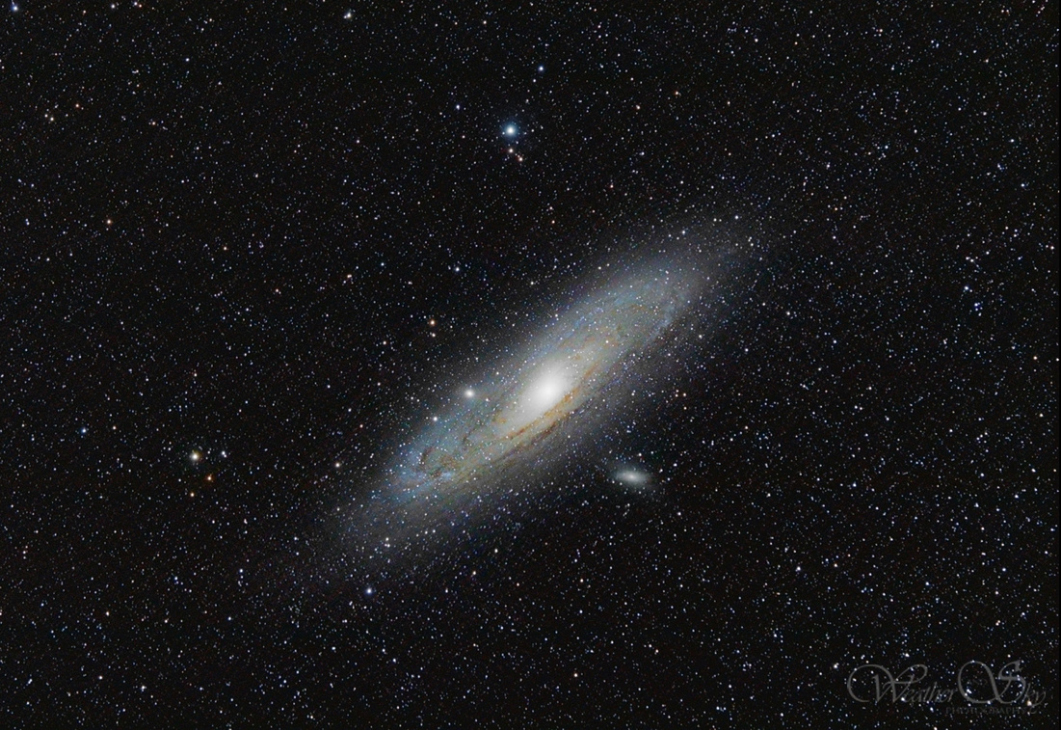
Credit: Kerry Ann Lecky Hepburn, www.weatherandsky.com
Named "Messier Object 31" in French astronomer Charles Messier's Catalogue of Nebulae and Star Clusters, Andromeda was first thought to be a nebula - a cloud of gas and dust - somewhere within our own Milky Way. It wasn't until the early 1900s that astronomers began to realize that these distant objects were actually galaxies unto themselves.
To find Andromeda, look straight upward to the zenth, overhead, in the evening hours, off to the west starting around midnight, and it tracks towards the horizon throughout the early morning hours.

Credit: Stellarium/S. Sutherland
If skies are clear and generally free of light pollution, the galaxy should be faintly visible to the unaided eye, but focusing in with a pair of binoculars or a telescope will make the experience that much better.
M1 - The Crab Nebula
The first of Messier's catalogued objects, the Crab Nebula is an expanding cloud of gas caused by a massive star going supernova. Located around 6,500 light years from Earth, the exploding star was noticed in the year 1054 by Chinese astronomers and the nebula itself was spotted roughly 700 years later, by English astronomer John Bevis.
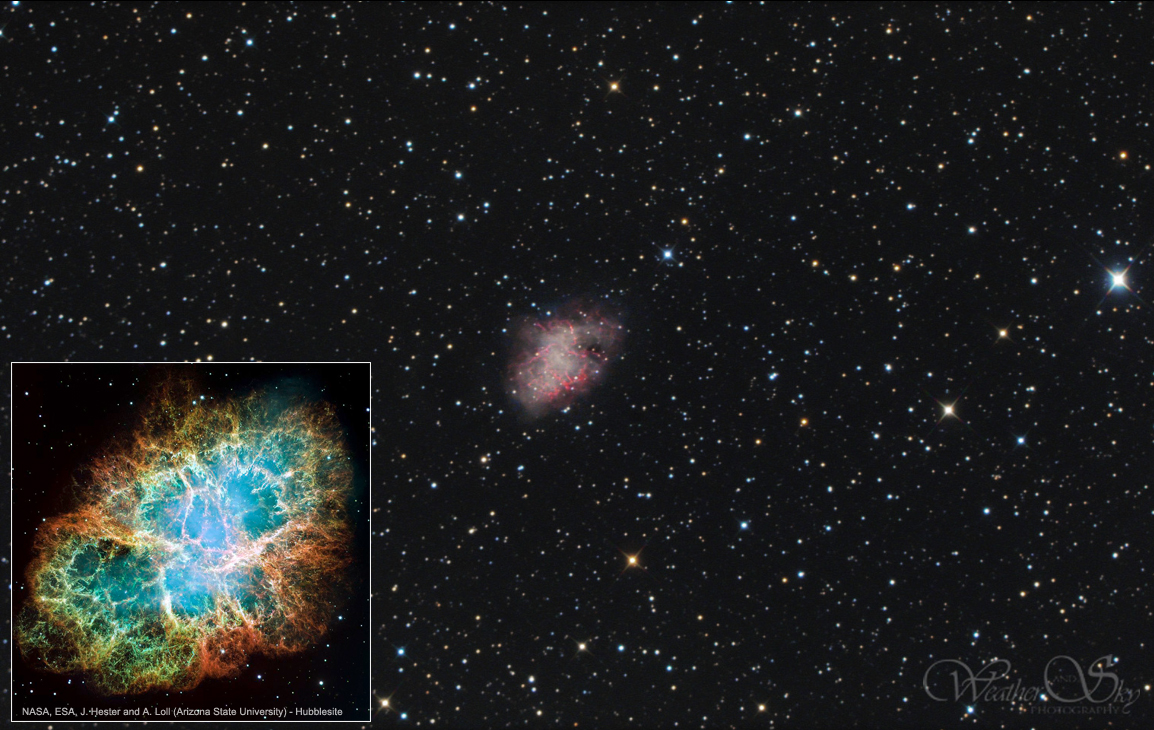
Credit: Kerry Ann Lecky Hepburn, www.weatherandsky.com. Inset: NASA, ESA, J. Hester, A. Loll (ASU)
The above image, a long-exposure picture taken by Weather Network meteorologist Kerry Ann Lecky Hepburn, shows what the nebula looks like through a typical backyard telescope. The inset image - a corresponding picture taken by the Hubble Space Telescope - shows off the amazing details of this object, which are lost to small telescopes.
M45 - The Pleiades Cluster
A regular sight in the northern sky, the Pleiades - aka "The Seven Sisters" - are visible on a clear night even without the benefit of a telescope or binoculars.
This tight grouping of young, blue stars tends to stand out in our night sky, even if you're dealing with suburban light pollution. This is partly due to their brightness and proximity to each other, but also because of the faint nebula of dust that surrounds them. Even though the nebula is very diffuse, it serves as an extra source of light for our eyes to focus on.
Through a telescope, however, this star cluster - which is a little over 400 light years away - really pops!
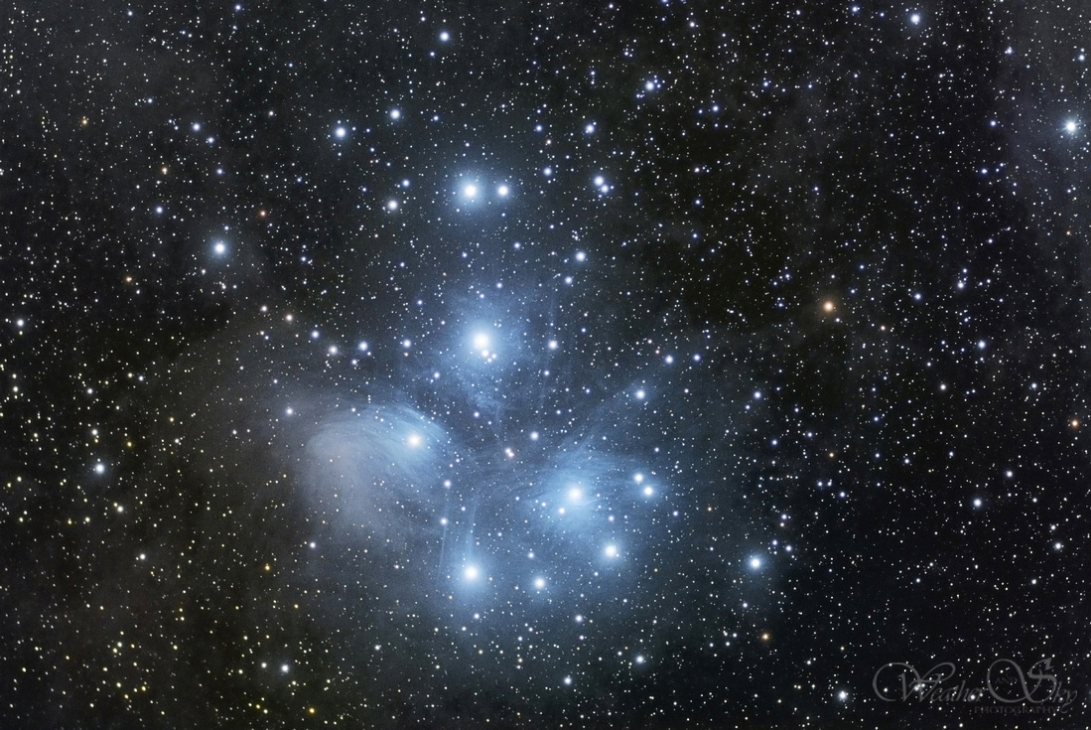
Credit: Kerry Ann Lecky Hepburn, www.weatherandsky.com
M42 - The Great Orion Nebula
Find the constellation Orion in the night sky - it's one of the easiest to spot, due to its distinctive shape - and you will find one of the most remarkable objects that we can see from Earth.
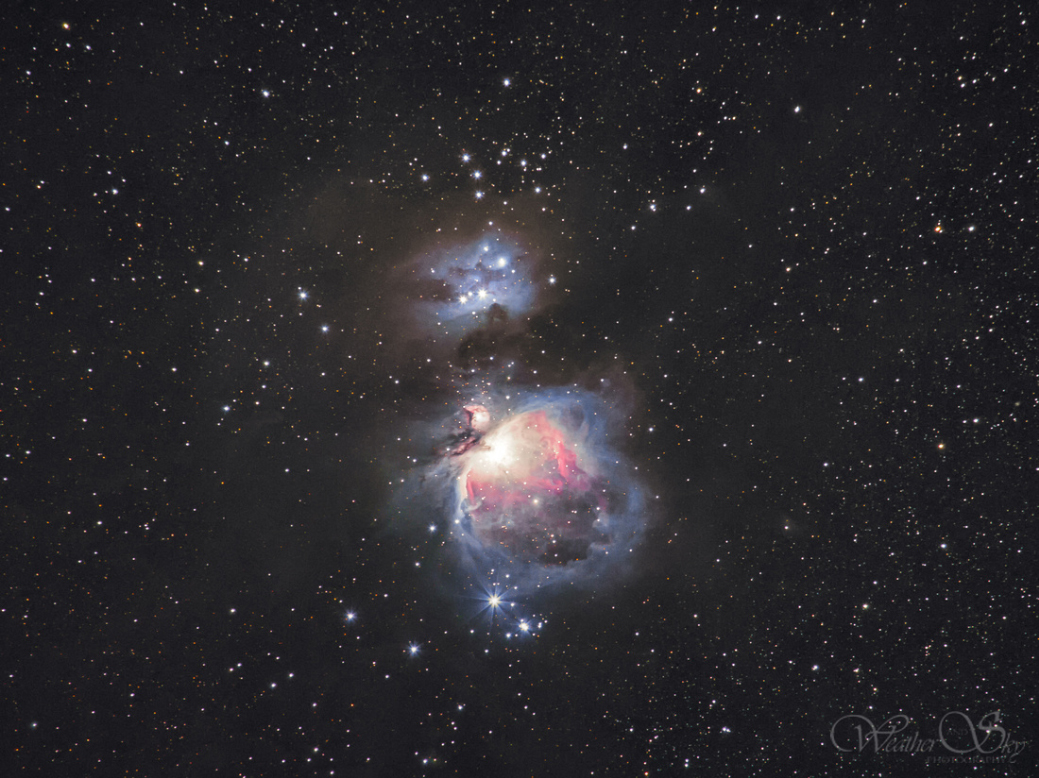
Credit: Kerry Ann Lecky Hepburn, www.weatherandsky.com
Located along the Sword of Orion, below Orion's Belt, the Great Orion Nebula is an immense cloud of dust and gas lit by intense radiation from the many stars that inhabit that region of space. Although it is over 1,300 light years away, it is also roughly 24 light years across. It is home to many new stars, and the region has been observed extensively by astronomers looking to study star and planet formation.
All three of these objects - M1, M45 and M42 - are located in the same general region of the sky as the constellation Orion, so locating Orion is a good start to finding them.
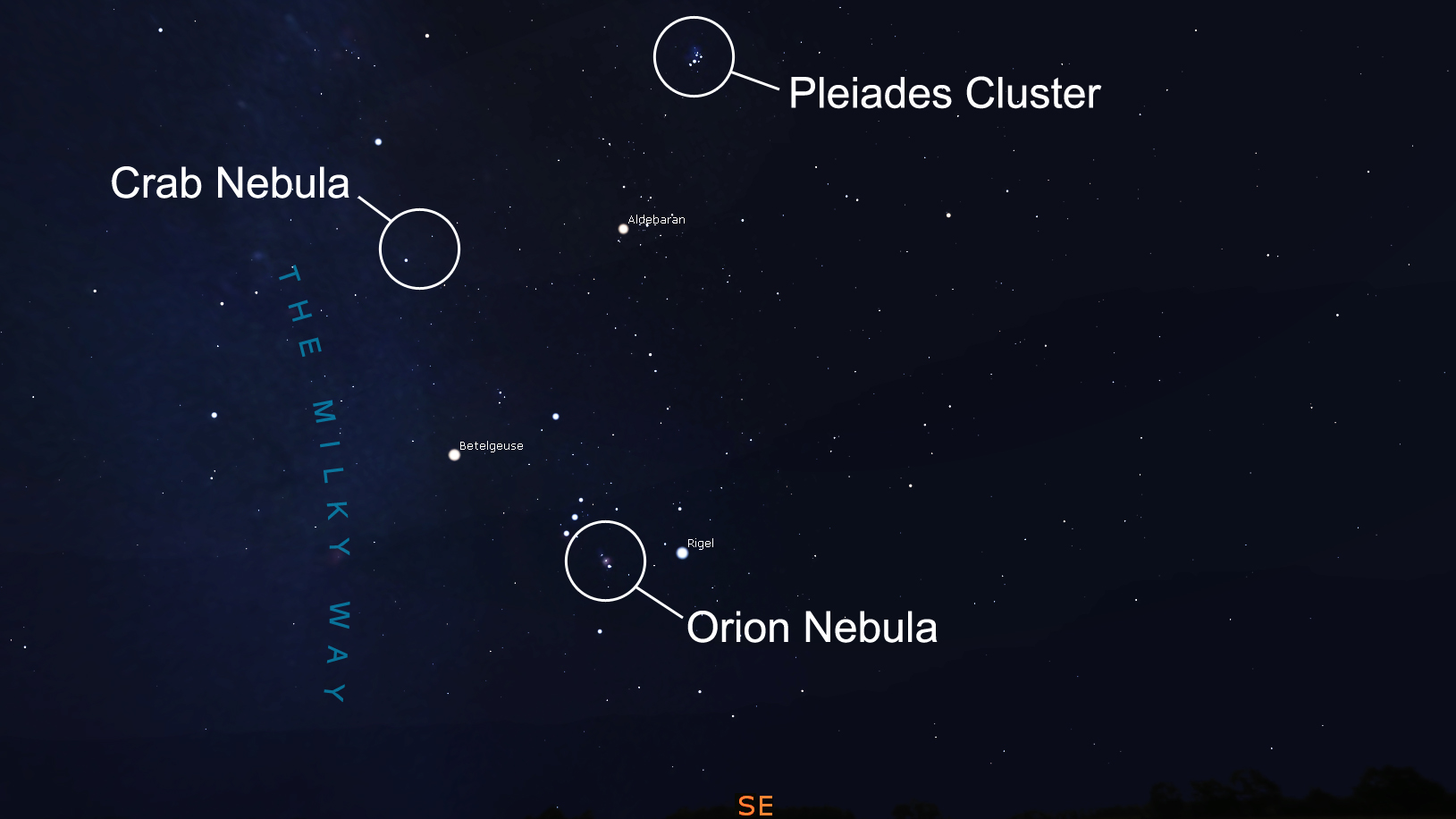
Credit: Stellarium/S. Sutherland
Look to the southeast in the hours after sunset to find Orion. The Crab Nebula forms a nearly equilateral triangle with the bright stars Betelgeuse and Aldebaran. The Pleiades should be readily visible, but if you need some guidance, follow Bellatrix - the bright star that forms Orion's shoulder, opposite to Betelgeuse - up to Aldebaran and continue on until you see the bright cluster.
The Double Cluster - NGC 884 and NGC 869
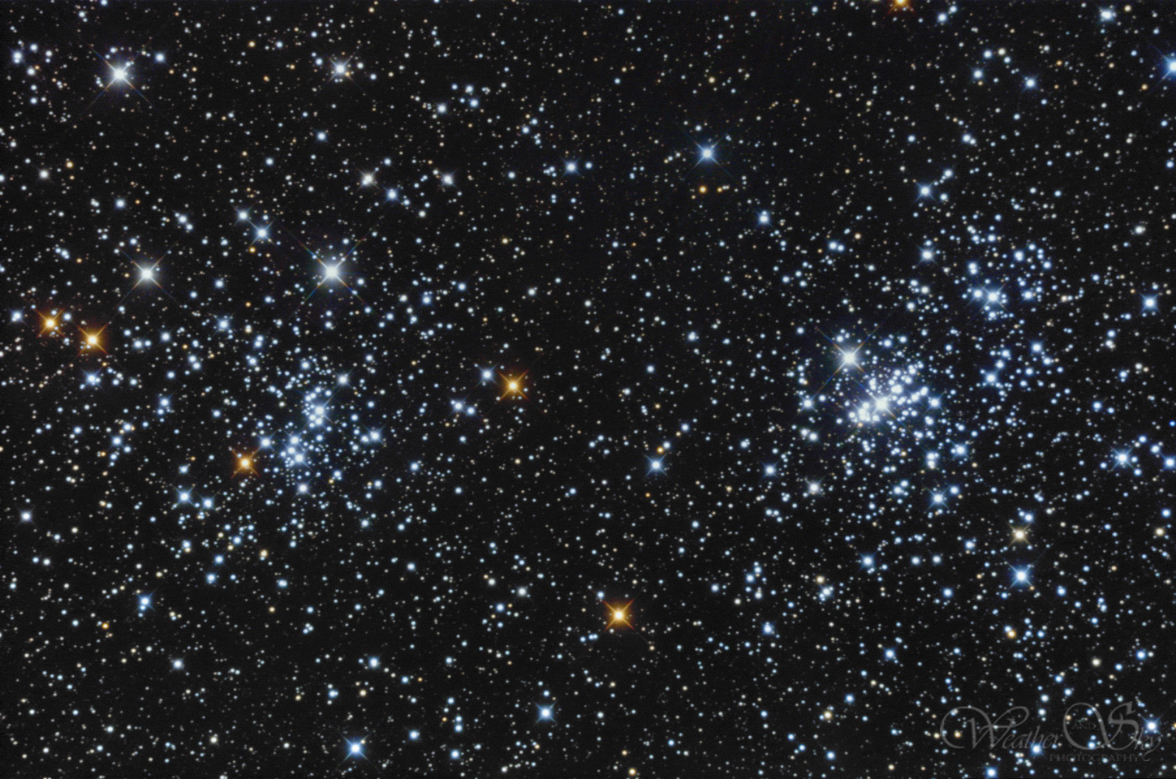
Credit: Kerry Ann Lecky Hepburn, www.weatherandsky.com
Roughly 7,500 light years away from us, these two clusters - Chi Persei on the left and h Persei on the right - contain many large bright stars, and are distinctive enough that the pair can be picked out in a reasonably dark sky just with the unaided eye.
Put a telescope between the eye and these two and the individual stars stand out, and the eye can even pick out the blues and oranges of these massive stars.
To find the Double Cluster, look for the bright star Capella, in the northeastern sky in the hours after sunset, and then follow the arc of the Milky Way upwards.

Credit: Stellarium/S. Sutherland
Cautionary Note
Something to keep in mind as you look at the above pictures is that they were produced by collecting light for some time to form the image. For example, Kerry Ann Lecky Hepburn's image of the Crab Nebula (minus the Hubble insert) is the result of gathered photons over a period of around 1 hour and 45 minutes, throughout several nights of observations in the Fall of 2010. By comparison, the human eye can only gather a small number of photons and it does not accumulate them over time. The eye does become more sensitive to light if given a chance to adjust to the darkness, however it also has a very fast refresh rate. So, while the brain can retain a memory of what the eye has seen, and build upon that, the eye cannot collect enough photons at once to see these objects in full colour.
Therefore, when looking at these objects through a backyard telescope, the details will be hazier and there will be little to no colour evident. Still, finding these objects and viewing them with your own eyes can still be a very rewarding experience, and depending on the night sky conditions and with a little patience, it's possible your eyes can pick out some amazing details.
Sources: WeatherandSky.com | NASA | Messier Objects
Related: Enjoy this Hubble Space Telescope view of the Great Orion Nebula!

The Great Orion Nebula. Credit: NASA, ESA, M. Robberto (STSI/ESA) and Hubble Space Telescope Orion Treasury Project Team



